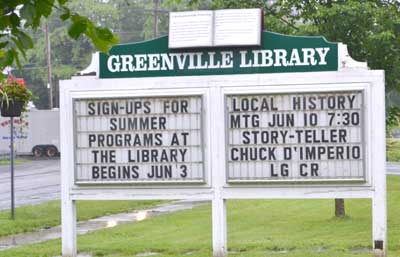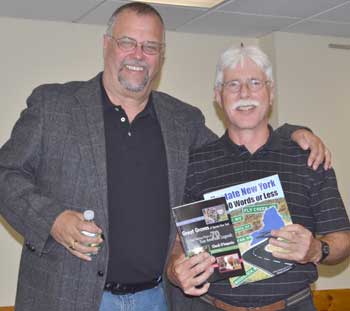subscription newsletter text is here, as are photos
past newsletters are available at: http://www.dteator.com/glhg/glhg.htm
It was story-telling at its best – good delivery,
places we know or have heard of, interesting people even if had not known
them before this night. Chuck D’Imperio spun a web of stories he has
found along his way in Upstate New York, more of which can be enjoyed in
his books.
I had heard Chuck once before at Gilboa and, upon returning home
and inquiring, realized that no one here had heard of him (sorry, Chuck,
but taken care of now). Knowing he would be an entertaining evening, I
arranged sometime mid-winter for Chuck to be a summer program. Of the four
dates open, he was available for only one, so we immediately booked June
10.
Chuck
hails from Sydney (Delaware Co), is a radio talk-show host in Oneonta
where he lives with his wife and children (four?), all of whom feature as
prominent footnotes in Chuck’s travels. Explaining how he got started,
Chuck explained that he would finish work on the radio at noon, with a
couple hours to putz and wait for the kids after school (his children are
still of school age, I believe). Looking for something to do, in addition
to the variety of side jobs he takes (features for the Times-Union being
one of them), he started looking for the stories that lie around us that
should be retold. And he shared three of them this evening, before doing
an encore or two or three.
One of the charming, convoluted, endearing, and funny stories
centered on a ride to a vacation destination in Vermont, with wife and
children rarin’ to start the vacation. It seems whenever he mentions,
“Did you see that?”, his wife senses a forthcoming stop to check a
possible story.
And the attention-getter he saw was in Whitehall, in Washington
County near the Vermont border, with a historical marker declaring
Whitehall to be the Birthplace of the American Navy. Wells, Whitehall does
not sit on the shore of any ocean or big body of water, and Chuck retells
how he found out why Whitehall is the birthplace of the American Navy, and
writes it up in Upstate New York: History Happened Here.
(Quick aside: I bought, for the Historian’s
folders, not only the aforementioned book but also Great
Graves of Upstate New York: Final Resting Places of True American Legends
as well as Upstate New York: in 100
Words or Less. NOTE: Chuck has two other published books and, coming
out later this summer, a book about Unusual Museums, of course, in Upstate
New York.)
(Another quick aside: Chuck’s speaking style starts quietly, a
ho-hum-shucks-I-just-happened-to-see-something-that-got-my-attention air,
a repetition or two, a variety of facial expressions ranging from the wide
and generous grin to the puzzled eyebrow to a look that alerts the
listeners that another layer of the story awaits, and a range of voice
inflections, much like the background music in a scary movie that declares
that suspense is building!)
OK, back to the story. (This is kinda like Chuck’s
speaking style.) So, Chuck discovers the rest of the story, about Ethan
Allen, Benedict Arnold (before the betrayal), Lake Champlain, and so on.
But,… well, the audience
knew there was more coming! On his way out of town, on his way to
vacation, but barely, he saw a castle-like building on one of the hills
overlooking Whitehall. So, he inched his car and carload up an
increasingly ragged road toward the castle, found a creaky open door, and
eventually got invited into what is known today as Skene Manor. (His
patient wife is again delayed from vacation.) He told the story of the
Gothic clocktower, the wealthy wife, her well meaning husband who made
sure that his deceased wife was buried this side of the grave (in a
lead-lined casket, placed behind the bar), and the attempts to restore the
castle today.
Actually, I found Chuck’s retelling the chapter more interesting;
live action must have done it! Other places found in this book are:
Lockport, Waterloo, Syracuse, Albany, Roxbury, LeRoy, Wilmington, Albany,
Hoosick Falls, Ithaca, Rome, Prattsville, Ogdensburg, Van Hornesville,
Howe’s cave, Westfield Chittenango, Royalton, Hammondsport, Cardiff,
Sherrill, Oneonta, Schoharie, and Oswego. And you can read about them if
you want to borrow the book.
Meanwhile, Upstate New York:
in 100 Words or Less tells about 100 places, each in 100 words or
less. Also available to borrow.
(Another aside: Chuck pronounced his fondness for the old character
on the riding mower, who comes to the rescue, just when he (Chuck) is
stuck or about ready to give up, as in the story about the world’s
largest living sign, so obvious he wondered how he missed it driving into
Canisteo.)
Chuck’s first story of the evening came from Great
Graves, the second chapter of the book, retelling the story of Annie
Edison Taylor. And in Chuck-style, we find out that Annie is a
60-something woman, down on her luck, and she puts herself in a barrel on
the Niagara River and lets herself go. Becoming the first person to
survive the drop over the Falls, she launches her own publicity tour in
hopes of making enough money for a better life. It works for about a year
but then her fame fades (the plunge happens only a few days before the
assassination of McKinley in nearby Buffalo) and Annie dies “blind and a
pauper in the Welfare Ward of the Niagara County Home” in 1921. Chuck,
of course, tells the story better.
An oral addition to that chapter is Chuck’s much later visit to
the NYS Museum in Albany, accompanied by his son, who happened to spot,
very coincidentally, hanging above their heads during lunch, a picture of
the barrel (or, was it the barrel, I forgot?) that Annie used for the
Falls jump.
Chuck did tell a story or two more, one about the Grape Pie
Champion, at my request. Finally, Chuck ended his accounts, and sold and
signed books. Again, I have three of them in the Historian’s collection
now and I will be pleased to loan any of them.
A passing note: on my way home, I thought about Chuck’s stories, and reminisced about the story-tellers I have had the fortune of hearing—Walter Ingalls, Harriett Rasmussen (in her quiet way), Toot Vaughn, and so many more. And I should reassure everyone that we all, yes, I mean all, are story tellers, and the telling is more important than the wondering how we appear in public. So, get out there, and tell some stories. Better yet, tell some stories that resurrect worthwhile tales of the past that many may have forgotten. Even better-er (you can tell I was an English teacher!) yet is to write them down so others can share them years and generations later.


The evening had started at the end of a wet, soggy, 63° day – a tough June day. Still, we had about twenty-five brave the elements to share the evening. In attendance, from what I remember: Walter & Donna Ingalls, Christine Mickelsen, Stephanie Ingalls, Ron Golden, Bette Welter, Mary Heisinger, Bob and Marie Shaw, Robert & Johanna Titus, Lew & Sue Knott, Don & Deb Teator, Tim & Judy Adams, and Roger Morey. Sally & John Dyce are Coxsackie people but hail from Sydney, thus recognizing a hometown boy. And there must have been a few more but they are lost in the mists of my brain. (If you let me know who, I will mention them in the next newsletter.)
Starting the meeting, I retold how worthy and educational the Greene County Historical Society’s house tour was earlier in the month. The sites stretched from the U&D train station in Haines Falls to the Westkill–Spruceton Rd (I bet not many Greenvillers even have an idea where Spruceton is.
Our next meeting will be held in collaboration with the Civil War Round Table, on Wednesday, July 10. General and Mrs. Grant will make a special appearance, with the General talking tactics and war, and Mrs. Grant discussing a favorite topic—Morgan horses.
A thank you goes to Stephanie and Christine for taking care of refreshments so capably. (Much appreciated here; it is one facet of meetings I enjoy partaking in but would rather not have to arrange.)
I mentioned the Clematis Garden 2013 tour (past, by the time you get this newsletter), another worthy community-building event.
Another plaintive request of mine was for each of us to look at our photo albums and to label them. If you were not around, would other people know who are in the pictures and where the shot is taken? I note this because of a scanning session where most of the photos I saw could not be identified. And I have seen thousands of photos that get thrown out because no one can make sense of them, other than a generic, anonymous curiosity.
Looking ahead, our August meeting, sponsored with the Library, features a slide show of Greenville history. Although a few slides from last year’s show (the first one) will be repeated, I still have enough often seldom seen ones to keep things interesting. The focus in the second half of the show will be Norton Hill and Freehold.
On a local community note, stop into Tops (the former
Bryant’s), step inside twenty feet, turn around, and look at the front
wall. Stretching from entry door to exit door are vistas of local history,
all of which you have seen because of the photos in the Historian’s
files. From what I understand, Tops makes it a practice to include local
scenes in their stores, and a nice job was done for Greenville.
Also, Tops included a plaque that gives credit to the providers of
the photographs. The Greenville Local History Group, Town of Greenville,
and Deb and I are listed.
And although I can cheerlead for town events, people, business,
etc., I try not to unduly favor one side while ignoring others. So, excuse
me, for encouraging all of you to visit Tops, at least once, and see what
a positive change they have made from the previous year or so.
And, talking about changes in Greenville, the corner gas station
whose decline has been such an eyesore for close to half-dozen years is
being renovated into a café/eatery, with some additions and what should
promise to be a much more pleasant air to our main corners.
Another note for a local event. Greenville Laundromat and Nick’s
Pizza & Pasta is sponsoring the Greenville Festival during June 28-30
(I am hoping this newsletter gets to you in time), with live music on
Saturday and Sunday afternoons, with rides, vendors, games, car show, and
fireworks scheduled. Taking time to support such an effort is a Greenville
way of life.
Shown somewhere in here are a couple photos of the Chuck D’Imperio meeting.
Remember, Wednesday, July 10 for General and Mrs. Grant. (not our usual day of week!)
For those of you who came out on a soggy evening in June, thank you, and a pat on the back.
Take care,
.

June 2013 meeting: Mary H updating group on Civil War Round Table